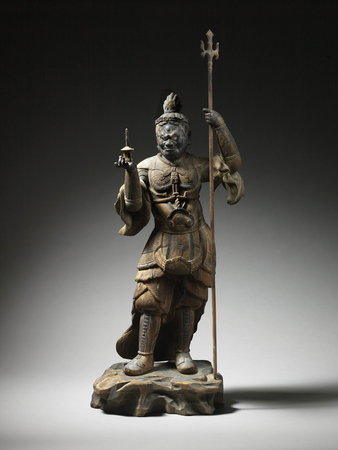Product Description
7730 A carved wood sculpture of Bishamonten (Vaiśravaṇa) wearing armour, holding a pagoda and a trident, the face with a fierce expression bearing gyokugan (inlaid crystal eyes), with traces of lacquer and pigments
Japan 12th/13th century Kamakura period
Dimensions:
Figure: H. 74cm x W. 42cm x D. 25cm (29¼” x 16¾” x 10”)
Figure, spear and stand: H. 100cm x W. 42cm x D. 26cm (39½” x 16¾” x 10¼”)
Provenance: private collection, Tokyo, Japan
Bishamonten originated in ancient Indian mythology as Kubera (Jp.: Kubira). He is the most powerful of the Guardians of the Four Directions (Shitenno, Four Heavenly Kings) and is the Guardian of the North quarter and as such is known as Tamonten (Listens to Many Teachings), he alone amongst the four is worshipped independently.
Bishamonten is the god of war and warriors and a dispenser of wealth and good fortune. He is considered a god of healing, with the power to save Emperors from life-threatening illness and to expel the demons of plague. He is aslo one of the Twelve Heavenly Beings (Juniten) and one of the Seven Gods of Good Luck (Shichifukujin).
His fierce expression, armour, glaring eyes and trident visually convey Bishamonten’s military role while the pagoda, with its South Asian origin as the funerary monument which enshrines the corporeal remains of the historical Buddha, symbolises the Buddhist teachings that he protects as well as being a reference to relic worship and reliquaries. Although absent in this figure it is also common for this protector of the faith to be depicted trampling two demons beneath his feet.
For other examples of Bishamonten figures see:
Hiromitsu Washizuka et tal. eds., Enlightenment Embodied: The Art of the Japanese Buddhist Sculptor (7th-14th Centuries), Japan Society exhibition catalogue, (New York, 1997), p.112-3, no. 16 (12th century, Heian period)
Asia Society Museum ed., Kamakura: Realism and Spirituality in the Sculpture of Japan, (New Heaven and London, 2016), p. 132-133, no. 39 (late 12th century, The Minneapolis Institute of Arts from the collection of Elizabeth and Willard Clark).
Victor Harris and Ken Matsushima, Kamakura: The Renaissance of Japanese Sculpture 1185-1333, (British Museum, London, 1991), no. 2 (by Kokei, 1188-9, National Treasure, Kofukuji Temple, Nara)
Miho Museum et al eds., Omi: Spiritual Home of Kami and Hotoke, exhibition catalogue, (Kyoto, 2011), p.180, no. 4 (Heian period, 9th-10th century, Important Cultural Property, Renjo-ji Temple, Shiga).
For examples of other Heavenly King figures see:
Miho Museum et al eds., Omi: Spiritual Home of Kami and Hotoke, exhibition catalogue, (Kyoto, 2011), p.81, no. 44 (Jikokuten, Heian period, 12th century, Important Cultural Property, Miho Museum, Shiga), p. 181, no. 5 (Komokuten, Heian period, 10th century, Chomei-ji Temple, Shiga), p. 220, no. 40 (Four Heavenly Kings, dated 1266, Chomeiji Temple, Shiga)
Radio Carbon Dating Ref: RCD-9284







